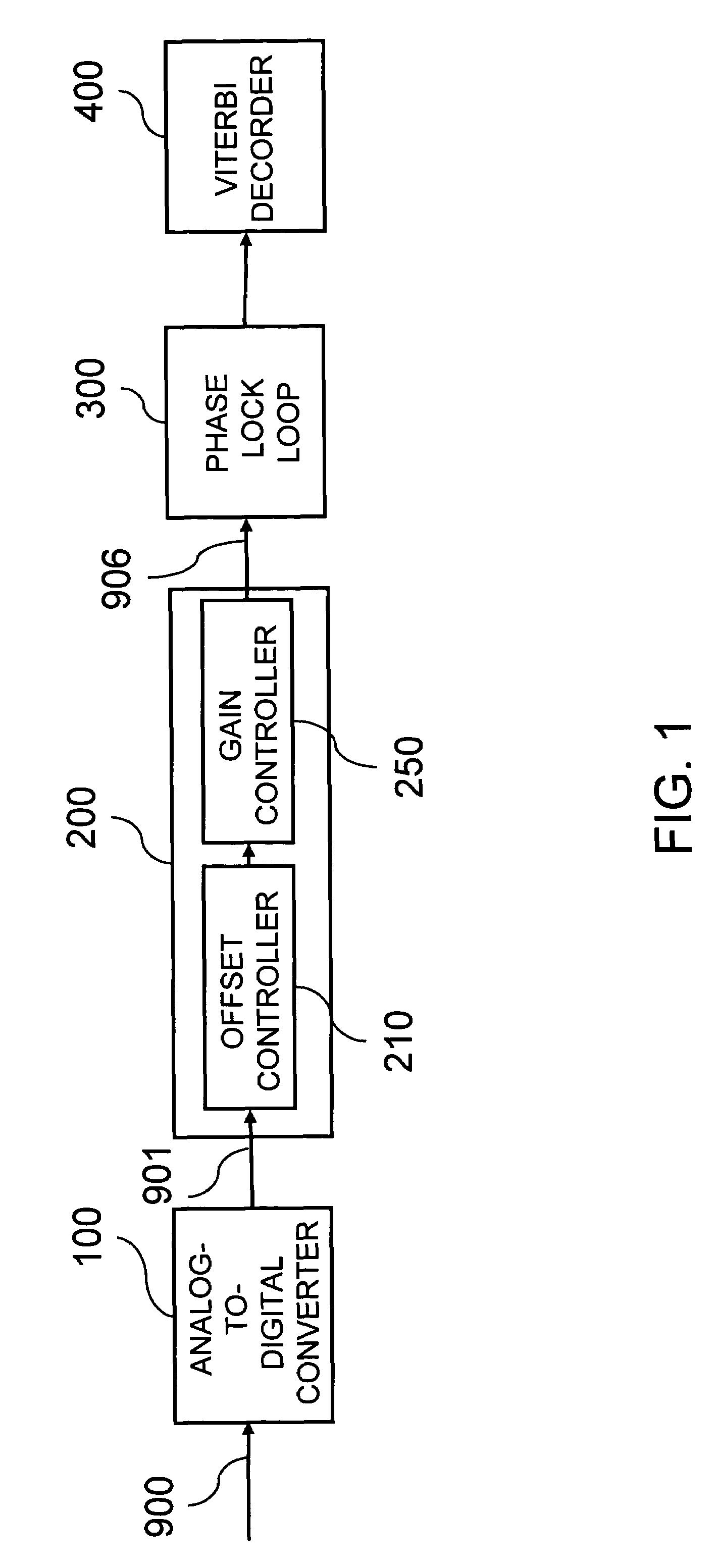Asymmetry compensator for partial response maximum likelihood (PRML) decoder
a partial response and maximum likelihood technology, applied in the field of asymmetry compensators, can solve the problems of increasing hardware complexity and expense, unable to completely compensate the asymmetry in the signal, and increasing the difficulty in discriminating the signal, so as to improve the effectiveness of the phase lock loop, easy hardware-wise, and easy debugging
- Summary
- Abstract
- Description
- Claims
- Application Information
AI Technical Summary
Benefits of technology
Problems solved by technology
Method used
Image
Examples
first embodiment
[0038]Refer to FIG. 1 for the system block diagram of the Asymmetry Compensator for Partial Response Maximum Likelihood (PRML) Decoder according to the invention.
[0039]As shown in FIG. 1, it shows the system structure of the Partial Response Maximum Likelihood (PRML) Decoder, including: an analog-to-digital converter 100, an asymmetric compensator 200, a phase lock loop 300, and a VETERBI decoder 400. Firstly, the analog-to-digital converter 100 is utilized to convert the regenerating signal 900 read from the optical recording medium. The regenerating signal 900 read from the optical recording medium is of an analog format, which is converted to the regenerating signal 901 of a digital format through the analog-to-digital converter 100. Then the regenerating signal 901 is removed from the asymmetric component through the asymmetric compensator 200. Subsequently, the regenerating signal 906, not having the asymmetric component, is phase locked by making use of the phase lock loop 300...
third embodiment
[0050]Then, refer to FIG. 5 for the asymmetric compensator according to the invention. In this embodiment, a corresponding table is established for the asymmetric compensator. From the table, the corresponding regenerating signal, not having the asymmetric component, can be obtained directly by its corresponding relations with the regenerating signal having the asymmetric component as read from the optical recording medium, in which the corresponding table is calculated from the amplitude and offset of the regenerating signal of the optical disk.
[0051]In FIG. 5, the asymmetric compensator as disclosed by the invention is composed of an adder 211, a comparator 212, an integrator 213, a controller 214, and a gain controller 250. Among them, the gain controller 250 is used to store a corresponding table indicating the corresponding relations between the regenerated signal having the asymmetric component, and the regenerating signal not having the asymmetric component. The functions and...
fourth embodiment
[0057]Furthermore, refer to FIG. 7 for the system block diagram of the Asymmetry Compensator for the Partial Response Maximum Likelihood (PRML) Decoder according to the invention.
[0058]As shown in FIG. 7, it shows the system structure of the Partial Response Maximum Likelihood (PRML) Decoder, including: an analog-to-digital converter 110, an asymmetric compensator 200, a phase lock loop 310, and a VITERBI decoder 410. Firstly, the analog-to-digital converter 100 converter is utilized to convert the regenerating signal 900 read from the optical recording medium. The regenerating signal 900 read from the optical recording medium is of an analog format, which is converted to the regenerating signal 901 of the digital format through the analog-to-digital converter 100. Next, the regenerating signal 901 is phase looked by making use of the phase lock loop 310. Then, the phase-locked regenerating signal is removed from the asymmetric component through the asymmetric compensator 200. Final...
PUM
| Property | Measurement | Unit |
|---|---|---|
| size | aaaaa | aaaaa |
| symmetry | aaaaa | aaaaa |
| stability | aaaaa | aaaaa |
Abstract
Description
Claims
Application Information
 Login to View More
Login to View More - R&D
- Intellectual Property
- Life Sciences
- Materials
- Tech Scout
- Unparalleled Data Quality
- Higher Quality Content
- 60% Fewer Hallucinations
Browse by: Latest US Patents, China's latest patents, Technical Efficacy Thesaurus, Application Domain, Technology Topic, Popular Technical Reports.
© 2025 PatSnap. All rights reserved.Legal|Privacy policy|Modern Slavery Act Transparency Statement|Sitemap|About US| Contact US: help@patsnap.com



